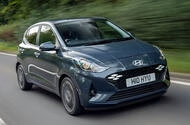Is the Hyundai i10 the Right Choice for Your City Driving Needs?
When it comes to small city cars, the Hyundai i10 has been making waves since its debut. With its recent facelift, this South Korean supermini is not just about frugality and style; it’s also about delivering a driving experience that feels a notch above its class. But with a market that’s becoming increasingly competitive, is the i10 truly a bargain, or does it fall short in some areas?
What’s New in the Hyundai i10?
The latest iteration of the i10 comes with a fresh look that’s both assertive and stylish. Hyundai has clearly put thought into the design, aiming to make a statement without going overboard. The updates aren’t just skin-deep; the i10 boasts a revised engine lineup and new tech features that enhance its appeal. With only a handful of rivals left in the supermini segment—like the MG 3, Toyota Aygo X, Dacia Sandero, and Kia Picanto—the i10 is positioned well to stand out. However, it’s essential to remember that these competitors have also received upgrades, making the market more cutthroat than ever.
What Are the Different Variants of the i10?
Hyundai offers the i10 in three main specifications: Advance, Premium, and N Line. The entry-level Advance model comes packed with features that include cruise control, an 8.0-inch touchscreen with Apple CarPlay and Android Auto, a rear-view camera, and a digital instrument cluster. If you opt for the Premium trim, you’ll enjoy additional perks like ambient lighting, voice commands, heated front seats, and wireless mobile charging. The N Line variant takes a sportier approach with aggressive front bumpers, red accents, 16-inch alloy wheels, and a more dynamic interior.
What Engine Options Are Available?
Under the hood, the i10 offers three engine choices. The base model features a 1.0-litre naturally aspirated three-cylinder engine that delivers 62bhp and 68lb ft of torque. For those looking for a bit more power, there’s a 1.2-litre four-cylinder engine producing 83bhp and 87lb ft. The standout option is the turbocharged 1.0-litre engine, which offers 89bhp and a robust 124lb ft of torque. It’s worth noting that the turbo engine is exclusive to the N Line trim and comes paired with a five-speed manual gearbox, while the naturally aspirated engines can be found in both Advance and Premium trims with either a five-speed manual or an automated manual gearbox.
How Does the i10 Handle on the Road?
When it comes to handling, the i10 sticks to a tried-and-true formula. It features MacPherson struts at the front and a torsion beam at the rear. However, Hyundai has made some tweaks to improve stability and steering response. The rear torsion bar has been redesigned into a U-shape, which enhances stability, while a stronger steering torsion bar and quicker steering gear aim to provide a sharper driving experience.
Is the i10 Worth Your Money?
With its competitive pricing and a solid list of features, the Hyundai i10 presents a compelling case for city dwellers. It’s designed to be economical, stylish, and practical, making it an attractive option for those looking for a reliable small car. However, potential buyers should consider their specific needs and preferences. If you prioritize a sporty drive and advanced tech features, the N Line might be the way to go. On the other hand, if you’re looking for a budget-friendly option that still delivers on essentials, the Advance or Premium trims could be perfect.
The big takeaway? The Hyundai i10 isn’t just about being cheap—it’s about offering value. With its blend of style, practicality, and updated features, it’s a strong contender in the city car market. Whether you’re navigating tight urban streets or looking for a reliable daily driver, the i10 is worth considering. So, why not take one for a spin and see how it fits into your lifestyle? You might just find that it’s the perfect match for your city adventures.

